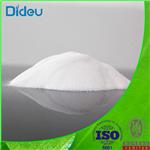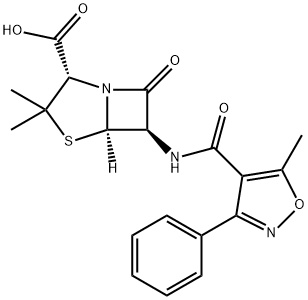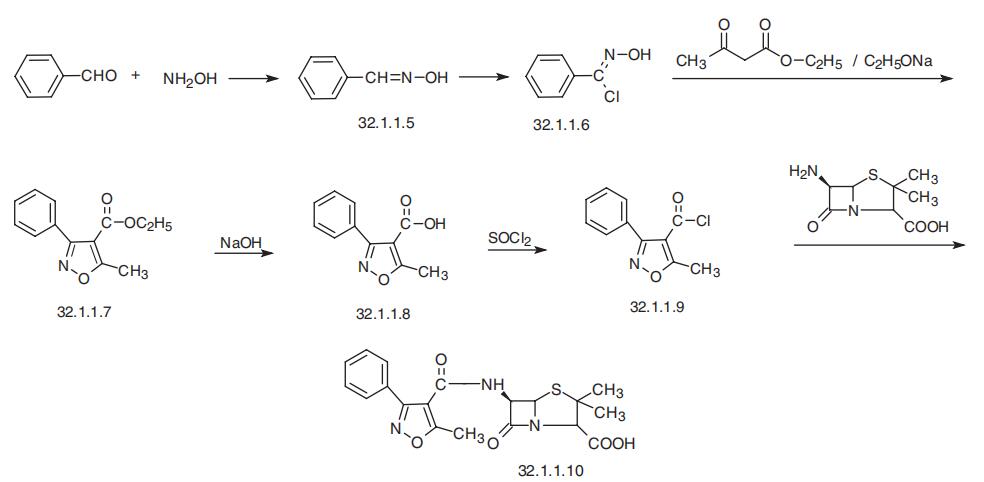| Company Name: |
Ebenezer Industries
|
| Tel: |
|
| Email: |
info@ebenezerindia.in |
| Products Intro: |
Product Name:Oxacillin
CAS:66-79-5
Purity:98% Package:1 kg,5 kg, 10 kg,25kg and 1 MT
|
- Oxacillin
-

- $200.00 / 1Kg
-
2023-06-28
- CAS:66-79-5
- Min. Order: 1Kg
- Purity: 99.0%
- Supply Ability: 20 tons
|
| | OXACILLIN Basic information |
| Product Name: | OXACILLIN | | Synonyms: | OXACILLIN;[2S-(2,5,6)]-3,3-dimethyl-6-(methyl-3-phenylisoxaz-4-ole-carboxamide-7-oxy-4-thia-1-azabicyclo[3.2.0]heptane-2-carboxylic acid;(2S,5R,6R)-3,3-Dimethyl-6-[(5-methyl-3-phenylisoxazol-4-yl)carbonylamino]-7-oxo-4-thia-1-azabicyclo[3.2.0]heptane-2-carboxylic acid;Bactocil;Oxazina;Penstapho;UWYHMGVUTGAWSP-JKIFEVAISA-N;4-Thia-1-azabicyclo[3.2.0]heptane-2-carboxylic acid, 3,3-dimethyl-6-[[(5-methyl-3-phenyl-4-isoxazolyl)carbonyl]amino]-7-oxo-, (2S,5R,6R)- | | CAS: | 66-79-5 | | MF: | C19H19N3O5S | | MW: | 401.44 | | EINECS: | 200-635-5 | | Product Categories: | | | Mol File: | 66-79-5.mol |  |
| | OXACILLIN Chemical Properties |
| | OXACILLIN Usage And Synthesis |
| Description | Chemically this is 3-methyl-5-phenyl-4-isoxazolyl penicillin. It was
synthesized in 1961 and has been extensively used in North America.
It is available as an oral solution of 120 mg/5 ml. It usually comes in an injectable formulation of 1 and 2 g. A 10-g injectable formulation is also marketed. | | Originator | Resistopen,Squibb,US,1962 | | Definition | ChEBI: A penicillin antibiotic carrying a 5-methyl-3-phenylisoxazole-4-carboxamide group at position 6. | | Indications | In terms of the spectrum of antimicrobial action, oxacillin is analogous to benzylpenicillin.
However, it combines the resistance to penicillinase with durability in an acidic medium, which
allows it to be used not only intramuscularly, but also orally. It is used for infections caused by penicillinase-producing staphylococci that are resistant to benzyl- and phenoxymethylpeni�cillins (septicemia, pneumonia, abscesses, empyemia, osteomyelitis, infected burns, infected
wounds, and others). Synonyms of this drug are cryptocillin, liucipen, optocillin, totocillin, and
others. | | Manufacturing Process | (A) Benzaldoxime: (Reference, Vogel, Textbook of Practical Organic Chemistry, page 883) -Materials: (Theoretical yield, 121.1 grams of free oxime), 106.1 grams (1.0 mol) of benzaldehyde (NF grade), 69.5 grams (1.0 mol) of hydroxylamine hydrochloride (practical grade), 68.0 grams (1.7 mol) of sodium hydroxide (pellet).
Procedure: The sodium hydroxide is dissolved in 200 ml water and the benzaldehyde is added. With continued stirring the hydroxylamine hydrochloride is added in portions. Some heat is developed and eventually the benzaldehyde dissolves. The solution is stirred for 15 minutes and then cooled in an ice-bath. A waxy, crystalline mass separates, and after further cooling it is collected by suction and dried in air. Yield is 86 to 149 grams. This crude material is suitable for step (B).
(B) Benzohydroximic Chloride: [Reference, G.W. Perrold et al, J. Am. Chem. Soc., 79, 462 (1957)] - Materials: 121 grams (0.77 mol) of crude benzaldoxime from step (A), 500 ml of 8.3 N hydrochloric acid, chlorine.
Procedure: The crude product from (A) is suspended in the hydrochloric acid, cooled in an ice-salt mixture, and chlorine is passed into the mixture with stirring for ? to 1 hour. Transient blue and green colors may be noticed in the mixture during this time. The temperature will probably rise to 3° to 5°C. The solid is collected by suction filtration and dried for an hour or so on the filter before use in (C). If at all possible, it should be used on the day of preparation. Yield is 71 grams (after 1? hours on the filter).
(C) 5-Methyl-3-Phenyl-4-Isoxazolecarboxylic Acid: [Reference, A. Quilico and R. Rusco, Gazz. Chim. Ital. 67, 589 (1937); C.A. 32, 21177] - Materials: 71 grams (0.45 mol) of crude benzohydroximic chloride from (E), 78 grams (0.60 mol) of ethyl acetoacetate (practical grade), 34 grams (0.60 mol) of sodium methoxide (95% minimum), 400 ml of methanol (reagent grade).
Procedure: The sodium methoxide is cautiously added in portions to 200 ml of methanol with stirring. Some heat is evolved. To this warm solution is rapidly added the ethyl acetoacetate with continued stirring. The solution is stirred for 10 minutes and then cooled in an ice-salt-acetone mixture (-25°C). If desired a Dry Ice-acetone cooling bath may be used to shorten the addition time. The crude material from (B) is dissolved in 200 ml of methanol. At this point it is probably easier to filter this mixture by suction to remove a large amount of insoluble solid, which is probably sodium chloride. The solid may be rinsed with more methanol.
The filtrate is chilled in ice-water and added to the cooled methanolic solution of the sodium derivative of ethyl acetoacetate at a rate which keeps the temperature of the re. action mixture below 0°C. The addition time will be 15 to 20 minutes if ice-salt-acetone is used as a coolant. This reaction is extremely exothermic.
The reaction mixture is stirred overnight at room temperature and filtered to remove the sodium chloride. The filtrate is stripped in vacuo and the crude ester (literature reports MP 48°C) is dissolved in 150 ml of ethanol; 28 grams (0.70 mol of sodium hydroxide in 90 ml of water is added and the solution is refluxed for 2 hours. After removal of the ethanol in vacuo the residue is dissolved in water and extracted twice with ether. Dissolved ether is removed from the aqueous solution in vacuo and it is acidified to pH 2 with concentrated hydrochloric acid.
The crystalline crude acid is dried briefly and then recrystallized from acetonitrile to give 32 grams of white product; MP 193° to 194.5°C (literature reports 189° to 190°C). Concentration of the mother liquor gives an additional 5 grams of material having a MP of 192.5 to 194°C. The 37 grams of material represents an 18% overall yield from benzaldehyde.
(D) The acid is converted to the acid chloride by reaction with thionyl chloride.
(E) 5-Methyl-3-Phenyl-4-Isoxazolylpenicillin: A solution of 4.43 grams of 5methyl-3-phenylisoxazole-4-carbonyl chloride in 120 ml acetone was added
gradually to a stirred solution of 4.32 grams of 6-aminopenicillanic acid in 168 ml of 3% aqueous sodium bicarbonate and 50 ml acetone. When addition was complete the mixture was stirred at room temperature for 4 hours and then extracted with ether (2 x 200 ml), only the aqueous phase being retained. This aqueous solution was covered with 50 ml ether and adjusted to pH 2 by the addition of N hydrochloric acid. After separating the layers, the aqueous phase was extracted with two further 50 ml portions of ether. The combined ether solutions (which at this stage contained the free penicillin acid) were washed with water and then neutralized by shaking with 20 ml N sodium bicarbonate solution. The aqueous phase was separated, washed with ether, and evaporated at low temperature and pressure to leave the crude sodium salt of 5-methyl-3-phenyl-4-isoxazolylpenicillin as a white solid, which was finally dried in vacuo over phosphorus pentoxide and found to weigh 7.34 grams. | | Therapeutic Function | Antibacterial | | Antimicrobial activity | There is complete cross-resistance and
tolerance with other group 3 penicillins. Oxacillin is frequently
used to replace methicillin for standardized susceptibility testing
to detect resistant staphylococci. | | Acquired resistance | In addition to methicillin-resistant strains producing the low
affinity PBP 2a, rare methicillin-susceptible isolates of Staph.
aureus display reduced susceptibility to oxacillin, due to
incompletely defined chromosomal resistance mechanisms. | | Contact allergens | Oxacillin is a semisynthetic penicillin of the group M.
It is closely related to cloxacillin. | | Clinical Use | Uses are those of group 3 penicillins | | Side effects | There is cross-allergy with other penicillins and reactions are generally typical of the group. Abnormalities of liver function, especially elevation of transaminase levels, may occur, sometimes accompanied by fever, nausea, vomiting and eosinophilia. As with benzylpenicillin, neurotoxicity may develop on high dosage in patients with renal failure. Pseudomembranous colitis has been reported. | | Synthesis | Oxacillin, [2S-(2|á,5|á,6|?)]-3,3-dimethyl-7-oxo-6-(5-methyl-3-phenyl-4-isox�azolcarboxamido)-4-thia-1-azabicyclo[3.2.0]-heptan-2-carboxylic acid (32.1.1.10), is syn�thesized by reacting 5-methyl-3-phenyl-4-isoxazolcarboxylic acid chloride (32.1.1.9) with
6-APA in the presence of sodium bicarbonate. The 5-methyl-3-phenyl-4-isoxazolcar�boxylic acid chloride (32.1.1.9) is synthesized by the following scheme.
Reacting benzaldehyde with hydroxylamine gives benzaldoxime (32.1.1.5), which
when oxidized by chlorine gives benzhydroxamic acid chloride (32.1.1.6). This is reacted
with acetoacetic ester in the presence of sodium ethoxide, giving the ethyl ester of
5-methyl-3-phenyl-4-isoxazolcarboxylic acid (32.1.1.7). Alkaline hydrolysis of the result�ing ester gives the corresponding acid (32.1.1.8), which is reacted with thionyl chloride to
give the acid chloride necessary for acylation. 
|
| | OXACILLIN Preparation Products And Raw materials |
|